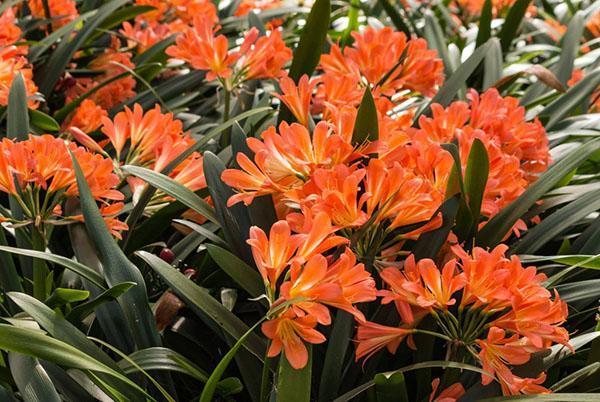Competent care of clivia is the guarantor of luxurious flowering
 Kaffir lily is not too demanding either on watering or on sunlight. Still, cleavage care includes several delicate nuances. Observing them, the gardener will be able to see flowering not only once a year, but more. So, up to 18 lovely buds are formed on one peduncle. Nevertheless, direct sunlight is contraindicated for her, so the pot is placed deep in the room or in the eastern part of the house.
Kaffir lily is not too demanding either on watering or on sunlight. Still, cleavage care includes several delicate nuances. Observing them, the gardener will be able to see flowering not only once a year, but more. So, up to 18 lovely buds are formed on one peduncle. Nevertheless, direct sunlight is contraindicated for her, so the pot is placed deep in the room or in the eastern part of the house.
In winter, the culture is left without watering, literally for two months. Nevertheless, they try to prevent wilting of foliage. Just noticing that they are weakened, they immediately add a little liquid.
Read also the article in the topic: photo of clivia and caring for her at home!
Clevia care taking into account all the nuances
To provoke a flowering plant after a dormant period, it is important to place it in a cool place (10-15 ° C). Still, you can get buds much earlier, if you create favorable conditions for this. However, it is worth remembering that in such cases:
- the peduncle will have a short stem;
- the plant has a breakdown;
- flowers will begin to develop poorly, which will lead to sudden wilting (not having time to open, they will immediately fall off).
When the process proceeds according to the standard scheme, then when the peduncle arrow appears, the flowerpot is transferred to a room with a temperature of 20-25 ° C. Next, the culture is watered, making sure that the water does not stagnate in the pot. During flowering, caring for the clivia is reduced to the fact that it is not rearranged from place to place, and also not turned.
Watering indoor specimens is recommended twice a week. In winter - after 21 days. The culture does not tolerate overflows, because it has fleshy thick roots in which moisture accumulates.
Planned transplant
Determining that a flower needs her is very easy. As soon as the massive rhizome fills the container and begins to stick out from it, it means that the culture is ready to change its place of residence. Pot pick up 2-3 cm (in diameter) more than before. Transfer is carried out carefully, trying not to catch the roots. If, nevertheless, some of them broke, then the sections are covered with charcoal.
Moreover, when transplanting, simple recommendations are taken into account:
- young seedlings need an annual change of scenery;
- seniors - once every three years;
- top dressing is applied from the very beginning of flowering every 14 days.
It is important not to overdo it with fertilization, otherwise the inflorescences will not be able to fully open. It is also important to choose the right pot, because in too large a tank it will take a long time to develop.
When a short peduncle grows, this indicates poor watering at the beginning of active development. Therefore, they begin to irrigate the flowerpot with warm water. The presence of rusty spots indicates burns, and the appearance of brown streaks indicates fungal diseases.
Re-flowering
At the end of summer, the clivia is transferred to a cool room or placed in partial shade. Reduce watering significantly. Then, after 14 days, the leaves will begin to dry out at the bottom of the bush. They can be safely separated and removed. This is the first sign of the formation of a flowering stem.
If the plant did not bloom, then it did not have a full dormant period, or it was constantly rearranged and turned. Abundant watering also stops the ovary formation process. Thus, it is important to pay special attention to the care of the clivia.